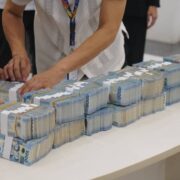PH firms turn more pessimistic in Q3

Businesses in the Philippines grew less confident in the third quarter, held back by the seasonal lull during the “ghost month” and the drag from US tariff headwinds, the Bangko Sentral ng Pilipinas (BSP) reported on Friday.
Consumers, however, turned slightly more optimistic, buoyed by expectations of rising incomes and improving job prospects.
A nationwide central bank survey of 1,523 companies found the business confidence index at 23.2 percent, down from 28.8 percent in the previous quarter. The figure remained in positive territory, meaning optimists continued to outnumber pessimists, but with a narrower margin as caution grew.
Respondents pointed to the usual slowdown in demand during the “ghost month,” compounded by the onset of the rainy and typhoon season. A shift in household spending toward school and other necessities at the start of classes also dampened firms’ outlook.
Companies likewise cited external risks, including higher US tariffs and geopolitical tensions, which they warned could erode demand in overseas markets.
For the fourth quarter, the central bank said the business confidence index rose to 49.5 percent from 39.3 percent in the previous survey, reflecting the usual surge in demand during the holiday season.
Expansion plans
Firms also pointed to process improvements and expansion plans as reasons for optimism, further buoyed by tame inflation that has remained within the government’s 2 to 4 percent target range. That brighter sentiment lifted the employment outlook for the final quarter of 2025 to 18.5 percent, suggesting hiring intentions may strengthen toward year’s end.
That momentum, however, may not carry into the new year. The confidence index for the next 12 months slipped to 48.1 percent from 51 percent in the prior poll, as companies braced for a postholiday slowdown in demand.
Concerns over higher US tariffs and geopolitical tensions abroad further weighed on the outlook. Even so, the employment index for the year ahead held steady at 26.2 percent, compared with 26.9 percent earlier, pointing to continued—if cautious—plans to expand headcount.
Consumer sentiment
On the consumer side, a separate survey of 5,416 households showed sentiment became less pessimistic in the third quarter, with the confidence index improving to –9.8 percent from –14 percent previously.
Respondents credited the shift to new income sources, more family members entering the workforce and the availability of stable jobs.
That rosier outlook appeared set to spill into the last three months of 2025. The central bank said the consumer confidence index for the fourth quarter climbed to 11.8 percent from 0.6 percent, with households anticipating more job openings and hoping for stable prices of goods and services.
Optimism also extended into the year ahead, with the confidence index rising to 14.1 percent from 11.8 percent in the prior survey. But households remained wary about making major purchases.
Buying intentions for big-ticket items over the next 12 months turned slightly more pessimistic, with the index slipping to –68.2 percent from –67 percent. Sentiment toward purchasing houses and lots weakened further, while demand for consumer durables and motor vehicles stayed in negative territory.
In a commentary, London-based Capital Economics said economic growth would remain steady at around 5.5 percent over the coming quarters, supported by consumer spending.
“On the plus side, consumption growth will remain resilient, helped by a combination of lower interest rates and subdued inflation. But this will be offset by drags from elsewhere,” it said.
“Fiscal policy is due to be tightened as the government tries to bring down the debt-to-GDP (gross domestic product) ratio, which rose sharply during the pandemic,” it added.





















